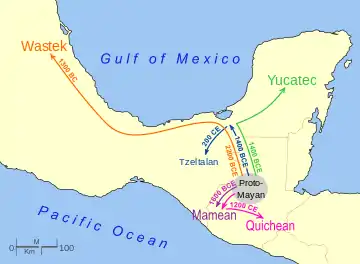Terrence Kaufman
Terrence Kaufman (born 1937)[1] is an American linguist specializing in documentation of unwritten languages, lexicography, Mesoamerican historical linguistics and language contact phenomena. He is an emeritus professor of the department of anthropology at the University of Pittsburgh.
Terrence Kaufman | |
|---|---|
| Born | 1937 |
| Title | Professor emeritus |
| Academic background | |
| Alma mater | University of California at Berkeley |
| Thesis | Grammar of Tzeltal (1963) |
| Academic work | |
| Era | 21st century |
| Discipline | Linguistics and anthropology |
| Sub-discipline | Mesoamerican |
Academic career

Kaufman received his PhD in Linguistics from the University of California at Berkeley in 1963 with his thesis on the grammar of Tzeltal.[2][1] Kaufman has produced descriptive and comparative-historical studies of languages of the Mayan, Siouan, Hokan, Uto-Aztecan, Mixe–Zoquean and Oto-Manguean families.
Due to his focus on gathering empirical documentation of unwritten languages through fieldwork and training of native linguists, Kaufman's list of publications is less extensive than those of other scholars in the field though many of his articles were co-authored with other scholars such as Lyle Campbell, Sarah Thomason and John Justeson.
In a 1976 paper co-authored with Lyle Campbell, he advanced a theory that the Olmecs spoke a Mixe–Zoquean language, based on the substantial presence of early Mixe–Zoquean loans in many Mesoamerican languages, particularly from specific, culturally significant semantic domains.[3] Along with Lyle Campbell and Thomas Smith-Stark, Kaufman carried out research published in Language (1986) which led to the recognition of Mesoamerica as a linguistic area.[4]
In Language contact, Creolization, and genetic linguistics (1988), co-authored by Kaufman and Sarah Thomason, the authors developed a theoretical framework for the understanding of the processes of contact-induced language change.[5]
Along with John Justeson, in 1993 he claimed to have successfully deciphered the Isthmian or Epi-Olmec script.[6] This claim has been rejected by anthropologists Michael Coe and Stephen Houston in 2004 after using the decipher key on a recently discovered jade mask. Coe states that the result "turns out to be total nonsense and gobbledygook,".[7][8] Kaufman is currently involved in the "Project for the Documentation of the Languages of Mesoamerica" or PDLMA, focused on collecting standardized linguistic data from the under documented languages of Mesoamerica.[9]

Selected bibliography
Articles
- Campbell, Lyle, and Terrence Kaufman. 1976. "A Linguistic Look at the Olmec." American Antiquity 41(1):80-89.
- Campbell, Lyle, and Terrence Kaufman. 1980. "On Mesoamerican linguistics." American Anthropologist 82:850-857.
- Campbell, Lyle, Terrence Kaufman and Thomas C. Smith-Stark. "Meso-America as a Linguistic Area", Language Vol. 62, No. 3 (Sep., 1986), pp. 530–570.
- Campbell, Lyle, Terrence Kaufman, "Mayan Linguistics: Where are we Now?" Annual Review of Anthropology, Vol. 14, 1985 (1985), pp. 187–198.
- Justeson, John, and Terrence Kaufman. 1993. "A decipherment of epi-Olmec hieroglyphic writing". Science 259:1703-1711.
- Kaufman, Terrence. 1976. "Archaeological and Linguistic Correlations in Mayaland and Associated Areas of Meso-America" World Archaeology, Vol. 8, No. 1, Archaeology and Linguistics (Jun., 1976), pp. 101–118
- Kaufman, Terrence. 1988. "A Research Program for Reconstructing Proto-Hokan: First Gropings." In Scott DeLancey, ed. Papers from the 1988 Hokan–Penutian Languages Workshop, pp. 50–168. Eugene, Oregon: Department of Linguistics, University of Oregon. (University of Oregon Papers in Linguistics. Publications of the Center for Amerindian Linguistics and Ethnography 1.)
- Kaufman, Terrence. 1990. "Language History in South America: What we know and how to know more." In Doris L. Payne, ed. Amazonian Linguistics, pp. 13–74. Austin: University of Texas Press.
Books
- Justeson, John, William Norman, Lyle Campbell, and Terrence Kaufman (1985). The Foreign Impact on Lowland Mayan Language and Script. Middle American Research Institute Publication 53. ISBN 0939238829.
- Kaufman, Terrence (1972). El Proto-Tzeltal-Tzotzil. Fonología comparada y diccionario reconstruido. México, UNAM. ISBN 978-9683666253.
- Thomason, Sarah G., and Terrence Kaufman (1988). Language contact, creolization, and genetic linguistics. Berkeley: University of California Press. ISBN 0-520-07893-4.
References
- Encyclopaedia of Language and Linguistics, 14-Volume Set, Volume 1-14 (Second ed.). Elsevier Science. ISBN 0080442994.
- "Terrence Kaufman Papers on Indigenous Languages of Mesoamerica". Survey of California and Other Indian Languages · California Language Archive. UC Berkeley. Retrieved 7 October 2020.
- Kaufman, Terrence (1 January 1976). "A Linguistic Look at the Olmecs". American Antiquity. 41 (1): 88.
- England, Nora. "Mesoamerican Languages". Oxford Bibliographies. Oxford University Press. Retrieved 8 October 2020.
- Language Contact, Creolization, and Genetic Linguistics. University of California Press. 12 February 1992. ISBN 0520078934.
- Justeson, John S. and Terrence Kaufman (1993), A Decipherment of Epi-Olmec Hieroglyphic Writing. Science, 19 March 1993, pp. 1703–1711.
- Kohn, David. "A TRANSLATION UNMASKED". Baltimore Sun. Baltimore Sun. Retrieved 9 February 2004.
- Bauman, Joe. "Secrets of old mask still hidden, duo say". Deseret News. Deseret News. Retrieved 27 January 2004.
- "Project for the Documentation of the Languages of Mesoamerica (PDLMA)". University of Albany. Way Back: University of Albany. Archived from the original on 8 October 2020.
- Campbell, Lyle (1997). American Indian Languages, The Historical Linguistics of Native America. Oxford Studies in Anthropological Linguistics, Oxford University Press
- Houston, Stephen, and Coe, Michael. 2004. "Has Isthmian Writing Been Deciphered?", Mexicon XXV: 151–161.
- Brigham Young University press release on behalf of Brigham Young University archaeologist Stephen Houston and Yale University professor emeritus Michael Coe disputing Justeson/Kaufman findings.
- Project for the Documentation of the Languages of Mesoamerica
- Kaufman's faculty page at the University of Pittsburgh
- Autobiographical notes by Kaufman
- "Works of Terrence Kaufman". Google Scholar.
